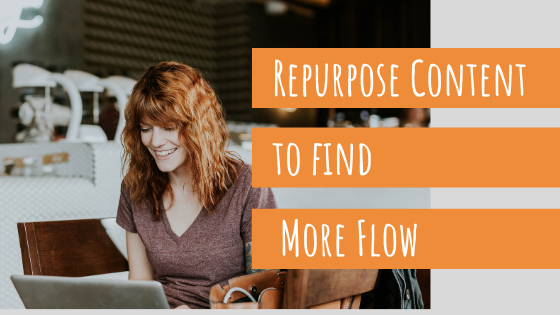When you repurpose content for your business, you get to work less but share more.
You protect your creative energy and avoid running yourself ragged. Without sacrificing keeping the information and inspiration flowing for your audience.
Plus, once you learn some of the tips and tricks of creatively repurposing your content, you’ll be able to make the best use of your individual thinking style. Woot!
So let’s dive in to how you can repurpose your content so you get the most bang for your buck when you sit down to write.
Repurpose Your Blog Post as an Email
Whenever you have a new blog post hot and fresh on your website, of course you want to let your subscribers now right away. After all, that’s why they signed up to be on your email list — they want to be the first to hear when your new ideas drop! (This is likely what most of us think of when we hear about “repurposing content.”)
You’ve got a couple options when it comes to sharing your blog posts via email.
- Use a teaser for your blog post and add a link or button readers can click to read the whole thing.
- Plop the entire blog post in an email (and then “newsletterify” it — details in a sec)
There are different benefits to each and you’ll probably find yourself using both methods at various times in your business.
Providing a teaser and a button gets your readers in the routine of clicking on the links you send them. You want to create an experience where folks click a button and then get something really valuable — your super-helpful blog post. This plants the idea in their noggins “click and get something awesome.”
This thought pattern is solid gold when you have an offer or event or product you want to share with your list. They’re already positively predisposed to click those buttons in your email because they know you offer great stuff on the other side of that click.
So, that’s one point for using a teaser.
On the other side, including the entire blog post in your email makes it incredibly easy for your subscribers to gobble up the great info, tips, how-to, encouragement, inspiration, etc. that you’re sharing.
For some people, a button can be a barrier to entry and they may not click to “read more” unless you’ve done a killer job of teasing your blog post.
Especially when folks are new to your list, it’s really helpful to provide the whole post in your emails so that they get the message your stuff is super valuable and know that it’s worth clicking to “read the full post on the blog.”
^^This means when you’re creating a welcome / nurture sequence for new subscribers, it’s a good idea to share your tips, tricks, and secrets directly in the emails — even if it’s coming from blog posts that already exist on your website.
By the way… You totally have permission to send out OLD blog posts in your newsletter! People who have joined your list more recently likely haven’t seen this useful information.
And, there’s no such thing as a 100% open rate for a newsletter. You might have some solid gold info that most of your list hasn’t seen.
Pro Tip:
Create a spreadsheet of what you send to your subscribers and include a column for the blog posts you share. This will make it easy to see how long it’s been since any given post got its day in the sun. You’ll avoid re-sending the same post again and again or letting those oldies but goodies get buried under new content.
Summary:
If you’re just getting started with content creation or finding your voice, put the whole dang post in the email so there’s no barrier to entry. Once you’ve got your “teaser” game dialed in, use a button and start training your list that clicking = awesome stuff!
Turn Your Blog Post into a Social Media Post
This tip is so simple that — I admit — I often forget about it. Maybe you’ve been leaving this one on the table as well?
Once you’ve put the energy into writing a great blog post, you want to make sure people read it. One strategy is to have a graphic you reuse that says something like “New post on the blog.” You can share this on social media, along with a quick sentence about what your post covers and a link (or a reminder that the link is in your bio if you’re posting on Instagram). This has the advantage of bringing people back to your blog and to your website, so it’s definitely a good strategy.
The disadvantage is that if people aren’t clicking the link to read the post, they aren’t seeing the value you’re offering. Like the blog-teaser-in-your-email strategy above, this works best once you’ve already demonstrated the value you offer to your followers. If you’ve been showing up and posting great stuff, this is your next best step to translate that good feeling folks have about you on social media into traffic to your website.
But, another great option is to take a section of your blog post and share it as a post on Facebook, IG, or LinkedIn. Pair it with an interesting or relevant image, and voila! you’ve got new content that you didn’t have to create anew.
You want the repurposed content to stand alone and deliver value / inspiration / entertainment / intrigue. So here’s a simple process to make sure you’re doing that:
- Add a hook to the beginning of the post. This could be a question that gets people’s attention, or a common scenario that your readers relate to.
- Take out any references to parts of the original blog post you’re not including. For example, you don’t want to say, “As I mentioned before…” if you haven’t included the previous mention in your excerpt.
- Add a punchy ending. This could be a question you want people to respond to in the comments, a tip, a call to action, or just a concluding sentence that neatly ties everything together.
It’s true, this method doesn’t bring folks back to your website. But it does make it really easy for them to see the value you offer. You’ll start building a reputation as someone worth listening to. This social credibility means more people are more likely to click through when you do share those “New post on the blog” posts.
Pro Tip:
Instead of sharing one section of your blog post, or you can summarize the post and share the big picture. For example, if you offer 3 tips or 5 reasons or 7 myths, you can share all of them in a shortened form, using emoji as bullet points to break up the text visually.
Summary:
Once you’ve published a blog post on your website, re-share the information either by summarizing it or sharing one section at a time on social media so that you build a reputation for sharing valuable content. Then use that reputation to get people to come over and read content on your blog so they’re visiting your website.
Blogify an Email or Social Post
When I work with clients one-on-one to help them find their voice and plan their blog, we dive deep into their writing process.
Some people more naturally think Top-Down — zeroing in on a topic they want to cover and then coming up with the details they’ll cover to flesh it out.
Others more naturally think Bottom-up — getting inspired by a certain detail and then working their way back up to the big topic they want to write about.
Why is this important?
Well, top-down thinkers may have an easier time coming up with some topic they want to write a blog post about, like The 5 Biggest Blogging Mistakes that Sap Your Energy.
But bottom-up thinkers likely come up with some details first. They may think of a story they want to share or an experience that gave them an insight. I worked with a really awesome bottom-up thinking client who got super inspired by quotes.
When that inspiration hits, you can tell the story or share the insight in an informal email to your list or in an Instagram story or post. If you’re a bottom-up thinker, it’s a lot easier to write a free-from email or post that shares your initial impression.
So here’s the system I taught to my awesome client who was inspired by quotes (and small moments in the day as well):
- Get out the thought in an easy, informal way by writing an email to your list or a social post. Send it / publish it.
- Let the thoughts simmer and evolve. (Best case scenario, talk them out into a voice recorder or with another human.)
- Create a new draft where you flesh out the idea and expand on it until you’ve got enough details to really make it meaty.
- “Blogify” your new draft by adding sections with headings, an intro, a conclusion, and a title that brings it all together.
- Publish your blog post and feel like rockstar!
Pro Tip:
Figure out whether you tend toward top-down or bottom-up thinking. Bring to mind the last 3 – 5 blog posts you wrote (or thought about writing). Did you start with a big picture idea, like “3 tips for making blogging easier”? Or were you inspired by a session with a client, a question, an image, or an experience first, building your way up to a bigger concept later–and maybe only once you started writing?
Summary:
You can work your way up to a blog post with a big overarching focus by collecting little moments of inspiration. Instead of waiting until those moments clarify into a big idea, you can share them as they hit you — via your emails or social media. This lets you organically build up to your big idea while also having content to share right now.
The Repurpose Content Circle
When you repurpose content, you’re not only getting more value from everything you write. You’re also getting a chance to use the process that works best for you.
You can get inspired by a quote, share it on IG with your take on it, and then expand that idea into a blog post.
You can plan blog posts from the top-down and then use one section at a time on Facebook to show your expertise in small, bite-sized chunks.
This allows you to create content from your flow. When you do that, you create faster, with more joy, and with greater consistency.
Want help finding your process and flow? That’s my jam! Let’s talk. Schedule your no-obligation discovery call to get clear on your next steps for writing in flow.

